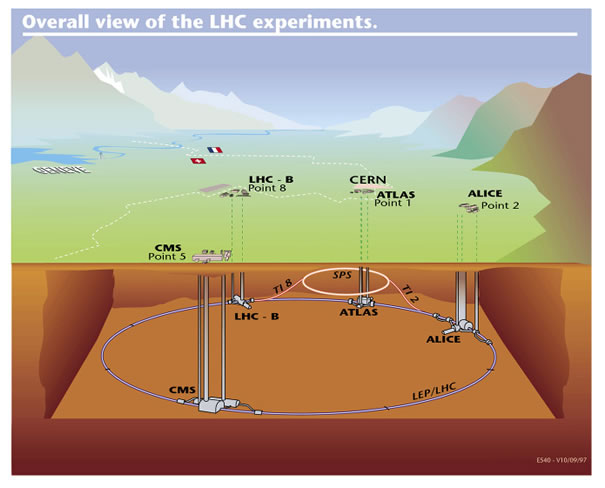Experiments at the LHC
The Large Hadron Collider is the world’s largest particle accelerator, accelerating enormous quantities of protons in opposite directions at energies of 7 TeV, reaching a total energy at collision of 14 TeV. This is 7 times the energy of the Fermilab collider, the Tevatron, in Illinois! The particles are “created” and injected into the accelerator which then travel in a circle measured at about 27 kilometers in circumference. The speed of the beam of particles increases close to that of light, which is approximately 300,000 kilometers per second. When the protons meet, the collision causes different particles to be created; particles with which we are familiar, and physicists hope, the birth of new undiscovered particles and phenomena.
Accelerators in general are made up of injectors, intermediate accelerators and a main machine, where the very high accelerating occurs. The detecting usually occurs at multiple detector sites, which are located at intervals along the tunnel, rather the main body of the accelerator.

- CMS (Compact Muon Solenoid) and ATLAS are experiments that will try to answer questions and solve problems about the universe, such as the possible existence of the Higgs mechanism, supersymmetry, dark matter and extra dimensions.
- ALICE (A Large Ion Collider Experiment) will investigate ultra-high energy proton-proton collisions and lead-lead collisions which may help in understand the beginning of the universe.
- LHCb (Large Hadron Collider Beauty) will be searching primarily for the decays of B mesons in attempts to investigate CP violation and why there is more matter than antimatter in the universe, as well as testing SUSY theories and the Higgs mechanism.
- There are two smaller experiments, LHCf and TOTEM, which will investigate more specific phenomena. LHCf (Large Hadron Collider Forward) is a set of smaller detectors that are located on either side of the ATLAS apparatus, about 450 feet from where the beams will collide in ATLAS, and will be analyzing ultra-high energy cosmic rays via neutral pion creations from ATLAS. TOTEM (Total Cross Section, Elastic Scattering & Diffraction Dissociation) is a set of silicon detectors located near the CMS apparatus that will be measuring the size of the proton.
